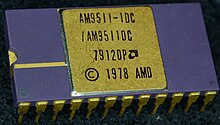DAI (computer)

The DAI was a personal computer, at that time still called home computer , by the Belgian manufacturer Data Applications International from 1980. The DAI was a very powerful computer when it was launched, but it was offered too expensive (in December 1982 for 2880 DM), so it could not prevail in the distribution.
Technical specifications
The hardware of the DAI computer was based on the 8080 A microprocessor and was designed as a single-board computer . The futuristic white case contained a high-quality keyboard for the time. As mass storage one was tape recorder used. The DAI could be connected to conventional television sets and already had color graphics. The dynamic RAM (max. 48 KiB) was divided into three separate memory areas ( memory banks ) containing 0, 4 KiB or 16 KiB of working memory . The DAI also had five programmable interval timers , two external interrupts and two serial I / O interrupts. RS-232 and a parallel interface (DCE bus from Data Applications) were available as interfaces . The BASIC of the computer worked semi-compiling. This means that the BASIC program was checked for syntactic errors as soon as it was entered and translated into an intermediate code that the interpreter could then process much faster.
In addition, an AMD -9511 math chip could be retrofitted if required.
Further technical data:
- CPU : 8080A, 2 MHz
- Memory: 48 KiB DRAM , 24 KiB ROM , 262 bytes SRAM
- Keyboard: 56 keys
- Presentation: color TV, 60 × 24 characters, 336 × 256 pixels
- Storage medium: Compact Cassette (600 baud )
- Tape drive (special equipment): DAI Memocom Data Recorder (used Philips microcassettes)
- Floppy disk drive (special equipment): Double 8-inch floppy disk station (this made CP / M operation possible.)
- Periphery : via the DCE bus ( DAI Real World Card System )
- Bus: DCE ( proprietary )
- Input ports: 2 paddles , RS-232
- Output ports: 2 stereo channels, RS-232
- System software: machine language utilities
- Programming languages: BASIC , 8080 assembly language
- a real hardware noise generator for generating random numbers
Web links
- DAI in Yet Another Computer Museum (English)
- DAI in 8-bit nirvana
- DAI at the Old Computers Museum (English)
- Le ParaDAI personal computer , a lot of detailed information and pictures, among other things for coupling DAI and PC (French)
